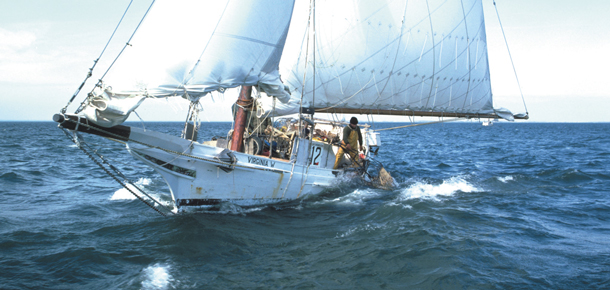Knauss legislative fellowships in Congress help build careers — and they're fun and educational. See our video and fact sheet for details.
Skipjacks

While many different ships roam the Bay’s waters, the most iconic is the skipjack, with its long lifting bowsprit, raked wooden mast and sweeping sheer lines. A reminder of the age of sail and symbolic of the Bay’s rich maritime history, it is the state boat of Maryland. First built in the 1890s for dredging oysters, they rose in popularity because they were cheap to build.
Watermen on the Eastern Shore who first built and sailed these ships gave them the early name of “two-sail bateau,” recalling a French connection to 17th century Huguenot exiles in the region. In other parts of Maryland, they were called “skipjacks,” thought to be named after the fast-moving skipjack tuna.
For a century, fleets of these graceful boats could be seen hauling oysters all winter long, finally becoming the “last working sailing fleet” in the nation. With the decline of oysters in the latter half of the 20th century, fewer and fewer of these old boats could be found. By the 1980s, there were only about two dozen skipjacks at work on the Chesapeake, all in Maryland. Today, there are only a handful still dredging for oysters. Most of the skipjacks now sailing the Bay are used for education and tourist trips and tours to teach about the history of the region’s coastal communities.
Learn more
Read Skipjacks for the 21st Century, an issue of Chesapeake Quarterly, Maryland Sea Grant's magazine, about the interaction between oyster reefs and skipjacks and the decline and recovery of both.
For a broad overview of the life and work of Chesapeake Bay watermen, check out the Maryland Sea Grant-published book Working the Chesapeake: Watermen on the Bay. Author Mark Jacoby spent time aboard ships with watermen who harvest Bay species in a variety of ways through all four seasons, hearing firsthand about their lives spent on the water.
Maryland Sea Grant has produced a series of videos (below) about skipjacks, "Oystering on the Chesapeake Bay." The videos focus on the City of Crisfield, its captain, and the preservation work that saved the boat, allowing it to continue hauling oysters.
- “A Century of Skipjacks”: A short introduction to the history of skipjacks in the Chesapeake Bay.
- "The Art of Oystering": Dredging oysters under sail with Captain Art Daniels Jr. of Deal Island, Maryland.
- "A Waterman and His Boat": "As long as you don't get afraid and stick with the boat, she'll stand by you." (Art Daniels, Jr.)
- “The Boat Coming Alive”: A veteran oyster captain recalls his first sail on his father’s skipjack.
- “A Skipjack Goes Down”: Captain Daniels tells of the day he found his skipjack, City of Crisfield, drowned at a Cambridge, Maryland, harbor dock.
- “And Rises Again”: Sail rigger Rich Schofield and boat builder Mike Vlahovich go to work rebuilding the City of Crisfield.
- “A (Re)Launch Party”: A look into the first success in an ambitious project to restore the last working sail fleet in the country.






